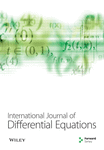Matrix and Inverse Matrix Projective Synchronization of Fractional-Order Time-Delay Chaotic Systems with Uncertainty
Abstract
In the present article, the matrix projective synchronization (MPS) and the inverse matrix projective synchronization (IMPS) have been analyzed with fractional-order chaotic systems with uncertain terms. First, we theoretically discussed both types of synchronizations. To achieve both types of synchronization, several required conditions are derived. We also drew portraits of Lyapunov’s exponents and bifurcation for more analysis. Furthermore, time-delay terms are also considered, giving an elegant application in real-world problems. Finally, numerical results agreed with the theoretical hypothesis. The numerical outcomes are shown through the graphical presentation.
1. Introduction
In 1963, Lorenz [1] generated a three-dimensional system that exhibits infinite complexity and nonrepeating trajectories with certain bounds. Furthermore, this system is known as the Lorenz system. In addition, Chen and Ueta [2] produced a different chaotic system currently referred to as Chen’s chaotic system, which is the twin of the previously mentioned Lorenz system. Lu and Chen [3] developed another chaotic system that was not diffeomorphic to Lorenz and Chen systems. Chaos is a kind of unpredictable phenomenon and sensitive to the initial value and makes its long-term behavior. In the last few decades, numerous researchers have been attracted to explore chaos and synchronization. Synchronization occurs when two or more nonlinear systems interact with each other, transforming the dynamical variables of the two chaotic systems. It started a new era in the field of science and has many applications in the field of the human brain [4] and secure communication [5], etc. Furthermore, from the past to the present, numerous efficient methods have been explored for various kinds of synchronization [6, 7].
Nowadays, fractional calculus has more application in numerous branches of science and engineering [8–11]. Compared to typical integer-order systems, fractional-order chaotic systems are more precise in revealing the dynamic behavior of the original systems. In fractional calculus, the usual differentiation and integration are generalized to any noninteger order [12–14]. Chua’s chaotic system was examined by Hartley et al. [15] with fractional calculus and showed that the systems of order less than three depict chaotic behavior. In addition, Li et al. [16] and Chen et al. [17] addressed the fractional-order chaotic systems and investigated the asymptotic stability by sliding mode control.
He and Pei [18, 19] showed the application of fractional-order neural networks to improve the computational ability of neurons for information transmission in the field of security communication. They further proved that the discontinuous system easily produces complex nonlinearity. He et al. [20] also using the sliding mode technique to enhance the high security and extended the projection scaling matrix in the study of global matrix projection synchronization for the delayed fractional-order neural networks.
An integer and noninteger order 4D chaotic system was studied by Rahman et al. [21]. A fractional operator is used to study the system and to prove the existence of solution. Jiang et al. [22] examined the complex dynamic behavior of chaotic systems and discovered that the system can display chaos and Neimark–Sacker bifurcation behaviors when a cross certain critical values. Using fractal fractional operators, Han et al. [23] also investigated the chaotic systems. Chen et al. [24] analyzed a memristive cellular neural network and achieved synchronization by the sliding mode control method. Zhu et al. [25] exhibited a classifier design technique and showed that extreme learning machines are more useful for rapid learning and good capabilities.
Due to the limited speed of transmission, time delay is a common occurrence in signal transition. The presence of delay terms can exhibit various complex phenomena such as hyperchaos, bifurcation, and multistability. For practical applications, it is necessary to introduce delays into chaotic systems. Moreover, several researchers have introduced fractional calculus in time-delay chaotic systems [26–28]. Mohammadzadeh et al. [29] proposed the synchronization of fractional delay chaotic systems via robust predictive control. In the study of lag projective synchronization, Zhang et al. [30] also considered fractional delayed chaotic systems and demonstrated that the slave system can synchronize up to a scaling factor.
Since uncertainty disrupts synchronization, it takes a great deal of work to study synchronization between chaotic systems with uncertainty. In matrix and inverse matrix projective synchronization (IMPS), an arbitrary matrix plays a fundamental role in controlling the response system. Moreover, when uncertainty is taken into account for chaotic systems, matrix projective synchronization (MPS) becomes more challenging in comparison to other synchronization techniques. Several results might be obtained in the literature to analyze the behavior of MPS. MPS for chaotic systems with uncertainty and disturbances was discussed by Shukla et al. [31]. He and Chen [32] discovered the matrix synchronization, stability analysis, chaotic behavior, and chaos control of fractional Rabinovich system. Khan et al. [33] also focused their research on the MPS of chaotic system with uncertainties and external disturbances.
- (1)
This manuscript is concerned with fractional-order delayed chaotic and hyperchaotic systems with uncertainty and an effort is made to determine the existence of chaos in the mentioned systems.
- (2)
Different gain matrices have been utilized for MPS and IMPS, respectively. MPS and IMPS of chaotic systems also have been attained and demonstrated graphically.
- (3)
The implications of uncertainty have been shown through graphical presentations.
The delayed fractional-order nonlinear dynamical model with uncertainty is still not much more explored. So, the authors concentrate on presenting the generic method for synchronizing the fractional-order delay chaotic systems with uncertainty. To the best of the author’s knowledge, this work has not been done before. This article is structured as follows. In Section 2, basic concepts of fractional delay system and related theorems have been recalled. In Section 3, the MPS analysis between chaotic and hyperchaotic systems has been conducted in subsections 3.1 and 3.2, respectively. Section 4 deals with IMPS of the chaotic and hyperchaotic systems in subsections 4.1 and 4.2, respectively. Numerical results and discussion have been presented in Section 5. A brief conclusion of the article is given in Section 6.
2. System Description
Here, we first present a definition as a reminder and then describe the considered chaotic system.
Definition 1 (see [43].)The Caputo’s fractional derivative is expressed as
Lemma 2 (see [44].)Let x(t) ∈ R is a continuous and derivable for t ≥ 0, then
Lemma 3 (see [45].)If (dγx(t)/dtγ) = η x(t) and 0 < γ < 1, η ≠ 1, then for η < 0, the system is asymptotically stable.
Theorem 4 (see [46].)The system (dγx(t)/dtγ) = x(t) is locally asymptotically stable if all the eigenvalues of the Jacobian calculated at its equilibrium point satisfy |arg(ω)| > πγ/2.
Now, consider two fractional-order delay chaotic systems with uncertainties as
Definition 5 (see [47].)Two systems (3) and (4) are said to have achieved the matrix projective synchronization whenever there exist a control function U(η, ξ) ∈ Rm and limt⟶∞‖y − κx‖ = 0, where κ is called the projective matrix.
Theorem 6. The master system (3) and slave system (4) will achieve the MPS if the controller U ∈ Rm fulfills
Proof. In case of MPS, the derivative of error system yields
The Lyapunov function is defined as
The derivative of V along with the trajectories (3) and (4) are obtained by using Lemma 3. It can be written as
By choosing the value of U such that
Definition 7 (see [47].)The systems (3) and (4) are said to achieve the IMPS if there exist a controller U ∈ Rm such that
Theorem 8. The systems (3) and (4) will achieve the IMPS if there is a control function U ∈ Rm such that
Provided that (A + α) is negative definite.
Proof. For IMPS, the error system is written as
Now, the Lyapunov function can be expressed as
By choosing the value of U such that
3. Study of Matrix Projective Synchronization
3.1. MPS between Fractional Time-Delay Chaotic Systems with Uncertainties
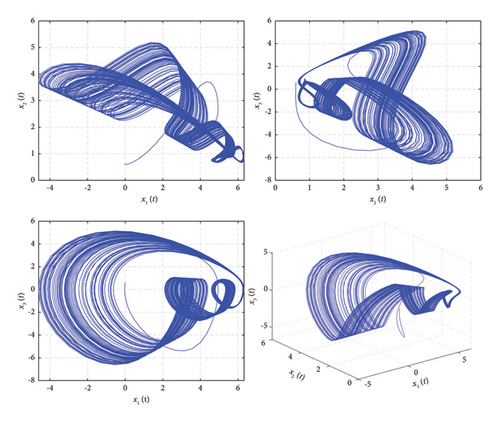
From Theorem 8, it is clear that MPS has been achieved since all the eigenvalues of the error system are negative. The phase portrait for the trajectories of the error system is depicted through Figure 2. Note that the convergence of trajectories towards zero reveals the MPS being achieved.
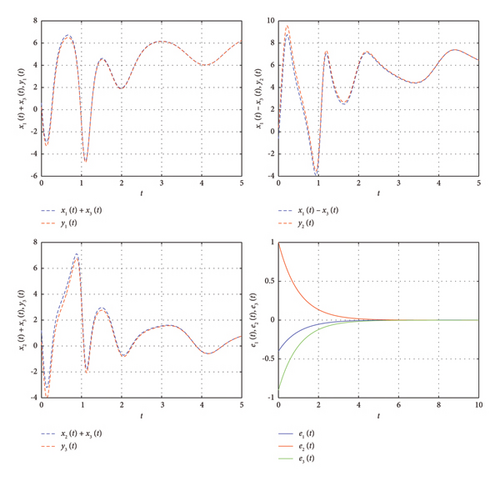
3.2. MPS between Fractional-Order Time-Delay Hyperchaotic Systems with Uncertainties
This system shows the chaotic characteristic for values a = 0.5, b = 0.5, c = 0.014 and γ = 0.98, τ = 0.01 at I.C. (0.01, 0.001, 0.001, 0.1). The phase portrait of (23) is illustrated in Figure 3.
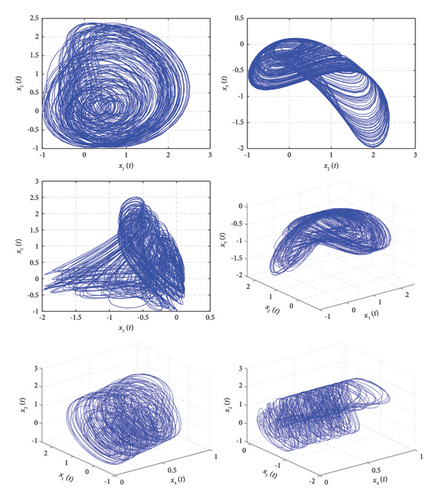
Since all eigenvalues are negative, we conclude that the MPS has been obtained, and the trajectories of error system also converge to zero (see Figure 4).
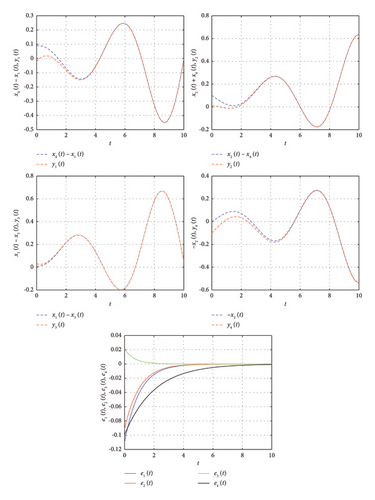
4. Study of Inverse Matrix Projective Synchronization
4.1. IMPS between Identical Chaotic Systems with Uncertainty
This system represents a chaotic behavior for values γ = 0.98 and τ = 0.01 at I.C. (0.2, 0.2, 0.2).
The eigenvalues of the error system are −1 , −1 , −1. It indicates that the IMPS has been achieved according to [46] because all the eigenvalues are negative. The graphical presentation of state variables of the error system is illustrated through Figure 5, which shows that the trajectories of the error system are convergent to zero, i.e., IMPS has been achieved.
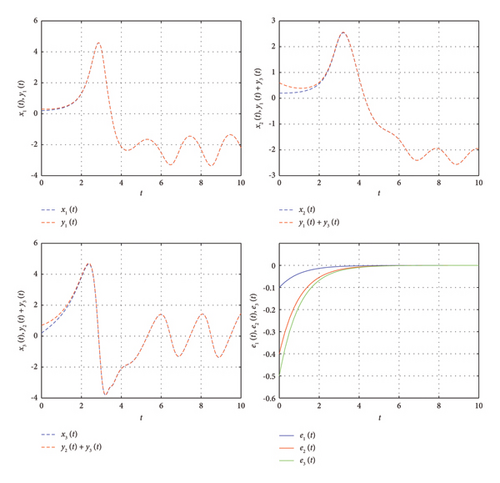
4.2. IMPS between Hyperchaotic Systems with Uncertainties
This system gives a chaotic behavior under the parametric values a = 20, b = 1, c = 10.6, d = 2.8, h = 0.45, k = 3.7, and τ1 = 0.01 at I.C. (0.09, 0.4, 0.9, 0.1).
The eigenvalues of the error system are −1, − 0.4, −2.8, and − 1, which indicates that the IMPS has been achieved. The error trajectories are demonstrated in Figure 6, and the convergence of the trajectories to zero guarantees the IMPS.
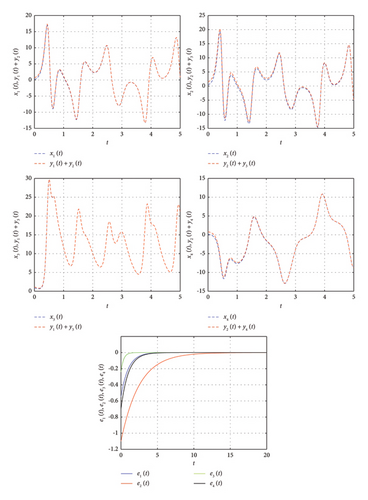
5. Numerical Results and Discussion
In the present section, numerical outcomes for fractional delayed chaotic and hyperchaotic systems will be discussed. First, the initial condition 0.6, 0.6, 0.6) is chosen for MPS of the chaotic system (16) with uncertainties. The trajectories of the mentioned chaotic system (16) are illustrated through Figure 1. The MPS has been achieved between delayed fractional identical chaotic systems. The error trajectories finally converge to zero which reflect that the MPS has been done (Figure 2). Subsection 3.2 of the article deals with the MPS of delayed fractional hyperchaotic system with the initial condition (0.01, 0.001, 0.001, 0.1). The three-dimensional phase portrait of state variables of the hyperchaotic system (23) is shown through Figure 3. The error dynamics of the hyperchaotic system are portrayed in Figure 4, which reflects that the synchronization completely takes place.
Second, IMPS has been discussed in subsections 4.1 and 4.2 for the chaotic and hyperchaotic systems, respectively. The initial condition for the system (31) was considered as (0.2, 0.2, 0.2) to achieve IMPS for identical delayed fractional chaotic systems with uncertain terms. Different delays have been considered to demonstrate the IMPS between systems (31) and (32). The phase portrait of the system (31) is shown through Figure 7 and the trajectories of the error system are observed in Figure 5. Furthermore, the parameters of the hyperchaotic system are taken as a = 20, b = 1, c = 10.6, d = 2.8, h = 0.45, and k = 3.7, with initial condition (0.09, 0.4, 0.9, 0.1) for system (39). The phase portrait of the hyperchaotic system (39) is shown through Figure 8. The time delay for hyperchaotic systems is taken as τ = 0.01. The IMPS has been achieved successfully between hyperchaotic systems (39) and (40), which finally converge to zero as depicted through Figure 6.
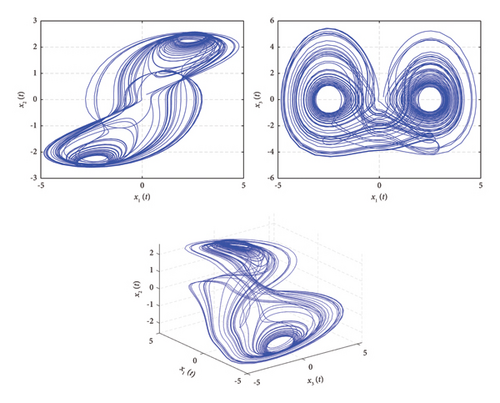
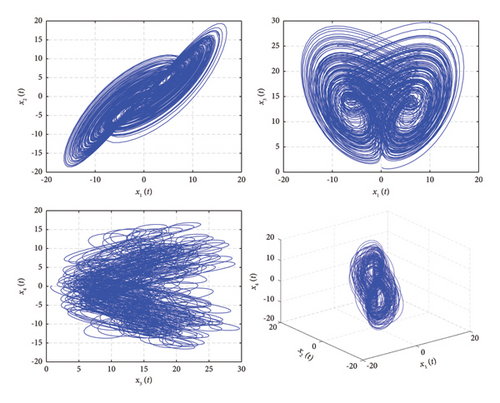
A chaotic system requires that at least one of the Lyapunov exponents be positive. Similarly, if a system has more than one positive Lyapunov’s exponent then this system is called a hyperchaotic system [52]. The system (16) has the Lyapunov’s exponents as λ1 = 0.0363, λ2 = −2.8327, and λ3 = −2.8644. System (16) is a chaotic system. Similarly, system (23) has the value of Lyapunov’s exponents λ1 = 0.19575, λ2 = −0.0760, and λ3 = −1.1197. Hence, it is also chaotic. In addition, systems (31) and (39) have the Lyapunov’s exponents as λ1 = 0.6239, λ2 = 0.2897, λ3 = 0.1834, and λ4 = 0.0269 and λ1 = 0.8788, λ2 = 0.0262, λ3 = −0.2704, and λ4 = −13.2574, respectively. Hence, both systems are hyperchaotic systems. The phase portraits of Lyapunov’s exponents of system (16), (23), (31), and (39) are shown in Figures 9, 10, 11, and 12, respectively. Numerical simulation of bifurcation diagrams is an efficient way to understand the intricate behavior of dynamical systems under parameter variation. As illustrated in Figure 9, the researchers analyze the response to changes in the parameters.
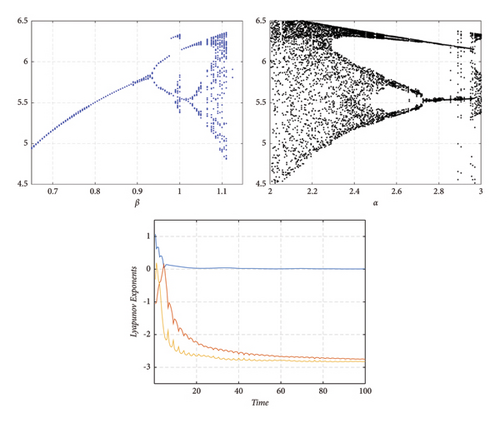
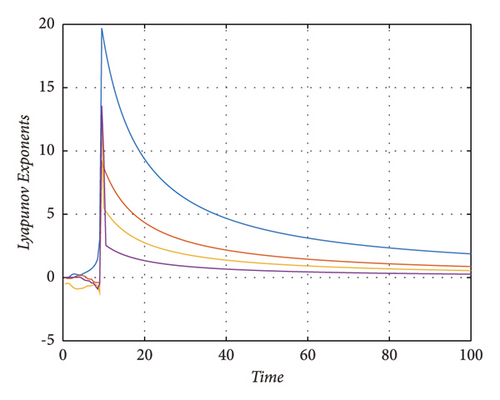
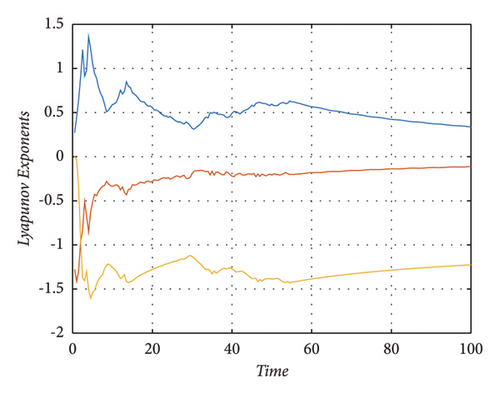
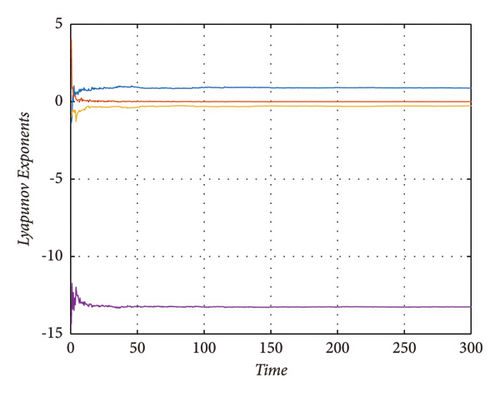
6. Conclusions
In this article, we have explored the matrix and inverse matrix projective synchronization of delayed fractional-order chaotic and hyperchaotic systems with uncertainties. First of all, the existence of chaos has been examined for chaotic and hyperchaotic systems, as shown graphically in Figures 1, 3, 7, and 8. The Lyapunov’s exponents show that these systems are chaotic and hyperchaotic in nature. The matrix and inverse matrix projective synchronization of chaotic and hyperchaotic systems have been accomplished by introducing different gain matrices. Figure 2 and 4 show the trajectories of the MPS error system, while Figures 5 and 6 show the IMPS error system. The implications of uncertainty have been shown via the graphical representations. The simulation outcomes for the synchronization of the chaotic and hyperchaotic systems showed the legitimacy of the proposed scheme. Moreover, the theoretical results agreed with the numerical outcomes.
Conflicts of Interest
The authors declare that they have no conflicts of interest.
Authors’ Contributions
V.K.S., M.C.J., and P.K.M. conceptualized the study; V.K.S., M.C.J., P.K.M., I.A., and S.E. performed formal analysis and the methodology; I.A. and S.E. are responsible for software; M.C.J. and S.E. performed investigation; V.K.S., M.C.J., P.K.M., and S.E. wrote the original draft; V.K.S. and S.E. reviewed and edited the study. All the authors have read and agreed to the published version of the manuscript.
Acknowledgments
The fifth author would like to thank Azarbaijan Shahid Madani University.
Open Research
Data Availability
Data sharing is not applicable to this article as no datasets were generated nor analyzed during the current study.



